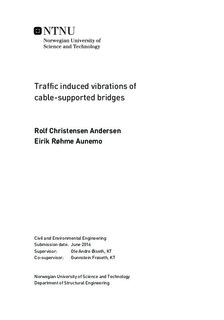Traffic induced vibrations of cable-supported bridges
Abstract
When considering cable-supported bridges, forces from wind and earthquakes often governsdesign. Heavy vehicles can also excite considerable vibrations on long and slender bridges,and may excite other frequencies in the bridge than the wind. If those frequencies are closeto the resonance frequencies of the bridge, this response will be critical. As such, it is ofinterest to accumulate knowledge considering characteristics of traffic induced vibrations onslender bridges.
In this thesis, methods for examining the traffic induced response on cable-supported bridgeshave been proposed. In order to identify traffic on bridges, and the response invoked by saidtraffic, numerical methods of analysing recorded data from existing bridge structures havebeen derived and reviewed, and a finite element analysis for simulating the effect of trafficloading on bridges has been established and investigated. A case study on the HardangerBridge was carried out as a means of verifying the methods. Recordings from accelerometersalong the bridge was used in the analysis, and a traffic logging at the site provided information regarding the actual traffic situation at the bridge for a time series.
It was found that heavy vehicles can be identified from the vertical acceleration response,as the frequency of the oscillations in the acceleration response increases significantly. The presence of passenger cars on the bridge does not seem to affect the acceleration response noticeably. The use of cross-covariance as a means of identifying moving loads and their characteristics, proved unsuccessful. Other factors than traffic seems to contribute to the acceleration response, and as such the cross-covariance did not provide satisfactory results due to the complexity of the response.
The power spectra of the recorded data revealed that heavy traffic excites eigenfrequencies mostly below one hertz, but also some higher eigenfrequencies. The attempts of filteringaway wind induced response, which is in general present below one hertz in the frequencyspectra, proved unsuccessful as most of the traffic induced response happens in the same frequency spectra as the wind. Because of this, the wind-traffic interaction on bridges appear to be significant, and should be considered in analyses.
Integration of the recorded accelerations was shown to give good results as a means ofobtaining displacements, with the exception of a non-existing eigenfrequency appearing andgetting excited with a high amplitude, providing some uncertainty regarding the results. Assuch further study on the subject is recommended.
The findings suggests that a finite element moving load model, consisting of a moving forcerepresenting each axle of the vehicle, may be used to conservatively estimate the responseof a bridge. The recorded data gives a smaller response than the Abaqus model, but the carloggings used for the recorded data were done during times of high wind velocities, whichis assumed to provide a stiffer response of the bridge. Further study on the wind-trafficinteraction, is recommended.
